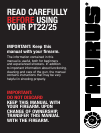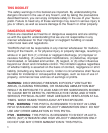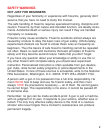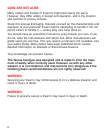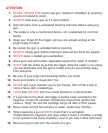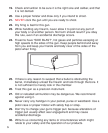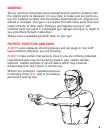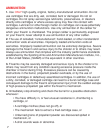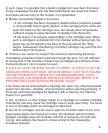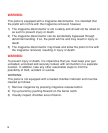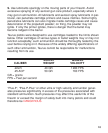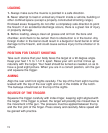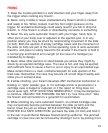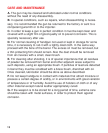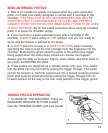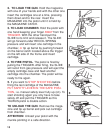
In such cases it is possible that a bullet is lodged part way down the barrel.
Firing a subsequent bullet into the obstructed barrel can wreck the firearm
and cause serious injury to the shooter or to bystanders.
5. Bullets can become lodged in the barrel.
• If the cartridge has been improperly loaded without propellant powder,
or if the powder fails to ignite (Ignition of the cartridge primer alone will
push the bullet out the cartridge case, but usually does not generate
sufficient energy to expel the bullet completely from the barrel).
• If the bullet is not properly seated tightly in the cartridge case. When
such a cartridge is extracted from the chamber without being fired, the
bullet may be left behind in the bore at the point where the rifling
begins. Subsequent chambering of another cartridge may push the first
bullet further into the bore.
6. If there is any reason to suspect that a bullet is obstructing the barrel,
immediately unload the firearm and look through the bore. It is not sufficient
to merely look in the chamber. A bullet may be lodged some distance down
the barrel where it can not easily be seen.
IF A BULLET IS IN THE BORE, DO NOT ATTEMPT TO SHOOT IT OUT BY
USING ANOTHER CARTRIDGE, OR BY BLOWING IT OUT WITH ABLANK
OR ONE FROM WHICH THE BULLET HAS BEEN REMOVED. SUCH
TECHNIQUES CAN GENERATE EXCESSIVE PRESSURE, WRECK THE
FIREARM AND CAUSE SERIOUS PERSONAL INJURY.
If the bullet can be removed with a cleaning rod, clean any unburned powder
grains from the bore, chamber, and mechanism before resuming shooting. If
the bullet cannot be dislodged by tapping it with a cleaning rod, take the
firearm to a gunsmith.
7. Dirt, corrosion, or other foreign matter on a cartridge can impede complete
chambering and may cause the cartridge case to burst upon firing. The same
is true of cartridges which are damaged or deformed.
8. Do not oil cartridges, and be sure to wipe the chamber clean of any oil or
preservative before commencing to shoot. Oil interferes with the friction
between cartridge case and chamber wall that is necessary for safe func-
tioning, and subjects the firearm to stress similar to that imposed by
excessive pressure.
8



